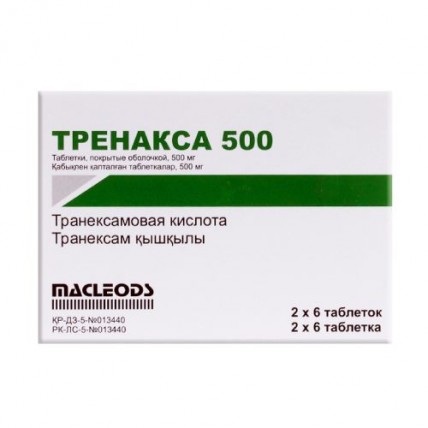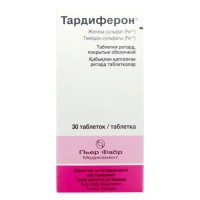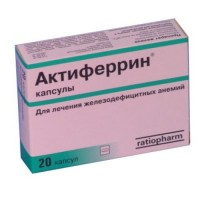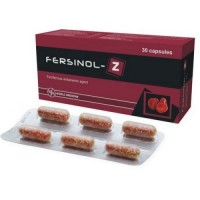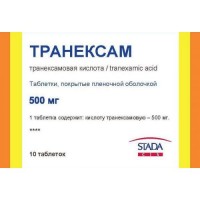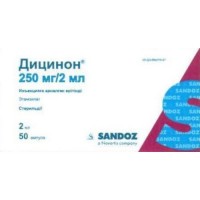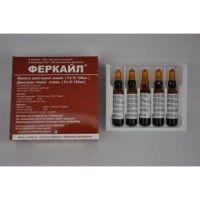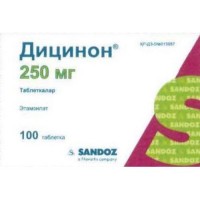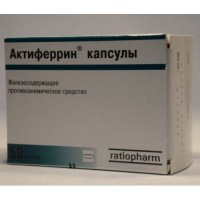Trenaxa (Tranexamic Acid) 500 mg, 12 coated tablets
- $26.60
Other brand names: Cyklokapron, Pause 500, Pausera, Cyclo-F, Espercil, Femstrual, Rikavarin, Transamin, Transcam, Traxyl, Lysteda
One tablet contains
active substance - tranexamic acid 500 mg,
auxiliary substances: microcrystalline cellulose (PH 101), povidone (PVP-K-30), microcrystalline cellulose (PH 302), croscarmellose sodium, colloidal anhydrous silicon, purified talc, magnesium stearate,
shell: hypromellose (5 cps), titanium dioxide (E 171), purified talc, propylene glycol, diethyl phthalate.
Pharmacokinetics
Absorption: after oral administration, from 30 to 50% of tranexamic acid (TC) is absorbed. The maximum plasma concentration is reached 2.17 hours after taking 500 mg of the drug and is 1.45 μg / ml. Food intake does not reduce the degree of absorption in the stomach and does not change other pharmacokinetic parameters of TC.
Distribution: tranexamic acid easily penetrates the blood-brain and placental barriers, the initial volume of distribution is 9-12 liters. In the synovial membranes and intra-articular fluid accumulates in concentrations close to serum. The concentration in many other tissues is lower than in the blood. In cerebrospinal fluid, the concentration of MC is about 10% of that in plasma. MC is found in semen, where it inhibits the fibrinolytic activity of the blood, but does not affect sperm motility. Binding to plasminogen - 2-3% of the therapeutic plasma concentration. Does not bind to plasma albumin. It remains in plasma for 4.52 hours. Bioavailability is independent of food intake.
Metabolism and excretion: the main route of excretion is glomerular filtration. More than 95% is excreted in the urine unchanged. An insignificant part undergoes biotransformation: N-acetylated derivative and deaminated decarboxylic acid are found in urine in insignificant amounts.
After oral administration of tranexamic acid at a dose of 10-15 mg / kg per day, the cumulative renal excretion after 24 and 48 hours is 39% and 41%, respectively, or 78% and 82% of the absorbed substance. After oral administration, metabolites are found in the following amounts: 1% dicarboxylic acid and 0.5% acetylated metabolite.
Tranexamic acid has antifibrinolytic effect.
Mechanism of action: competitively inhibits the plasminogen activator; in higher concentrations, TC is not a competitive inhibitor of plasmin.
The inhibitory effect of tranexamic acid on the activation of plasminogen by urokinase and streptokinase is 6-100 times and 6-40 times, respectively, greater than that of aminocaproic acid. The antifibrinolytic activity of tranexamic acid is approximately ten times that of aminocaproic acid.
For short-term use in case of bleeding or the risk of bleeding in patients with increased fibrinolysis or fibrinogenolysis.
Local fibrinolysis, which occurs in the following cases:
- prostatectomy, bladder surgery
- conization of the cervix
- menorrhagia
- nosebleeds
- traumatic hyphema
- tooth extraction in patients with hemophilia
- hereditary angioedema
The dosage regimen is individual, depending on the clinical situation. The tablets are taken orally, regardless of food intake, without chewing, drinking plenty of water.
Local fibrinolysis
The recommended standard dose is 15-25mg / kg body weight (2-3 Trenax 500 tablets or 4-6 Trenax 250 tablets) 2-3 times a day.
For the indications listed below, the following dosages may be used:
Prostatectomy
Prevention and treatment of bleeding in high-risk patients should be initiated before or after surgery with tranexamic acid injection;
then continue taking 2 tablets 3-4 times a day until the disappearance of macroscopic hematuria
Menorrhagia
The recommended dose is 2 tablets of Trenax 500 or 4 tablets of Trenax 250 three times a day with the duration of administration, depending on the need for up to 4 days. With very heavy menstrual bleeding, the dose may be increased. The total dose should not exceed 4 g daily (8 Trenax 500 tablets or 16 Trenax 250 tablets). Treatment with tranexamic acid should not be started before the onset of menstruation.
Nose bleed
In case of repeated bleeding, oral therapy is prescribed (2 tablets of Trenax 500 or 4 tablets of Trenax 250 three times a day) for 7 days.
Conization of the cervix
3 tablets of Trenax 500 or 6 tablets of Trenax 250 three times a day.
Traumatic hyphema
2-3 tablets of Trenax 500 or 4-6 tablets of Trenax 250 three times a day. Dose is based on 25 mg / kg 3 times daily.
Hemophilia
When removing a tooth, 2-3 tablets of Trenax 500 or 4-6 tablets of Trenax 250 every eight hours. Dose is based on 25 mg / kg 3 times daily. Hereditary angioedema
Some patients are aware of the onset of the disease; the recommended treatment for such patients is to periodically take 2-3 Trenax 500 tablets or 4-6 Trenax 250 tablets 2-3 times a day for several days. Other patients take the medication consistently at a given dosage.
Children
20-25 mg / kg of body weight per day by mouth. However, data on the use, efficacy and safety of these indications are limited.
Elderly
No dosage reduction is required if there are no signs of renal failure.
Renal failure
Tranexamic acid is excreted unchanged in the urine, therefore, for patients with renal insufficiency, lower doses are recommended than usual. For oral administration, the following dose adjustment is required:
Plasma creatinine
Dose
120-249 μmol / l
15 mg / kg body weight 2 times a day
250-500 μmol / l
15 mg / kg body weight once a day
Frequency is defined as: very often (= 1 / l0), often (= 1/100 to <1/10), infrequently (= 1/1000 to <1/100), rarely (= 1/10,000 to <1 / 1000) and very rarely (<1/10,000), not known (cannot be estimated from the available data).
Rarely
- skin allergic reactions
- violation of color vision
- occlusion of retinal veins and arteries
- thromboembolic complications
Very rarely
- hypersensitivity reactions, including anaphylactic shock
- malaise, weakness, dizziness, drowsiness, convulsions
- tachycardia, chest pain, hypotension with possible loss of consciousness
- thrombosis of arteries and veins
- dyspeptic symptoms: nausea, vomiting, diarrhea; anorexia
- hypersensitivity to tranexamic acid or any other ingredient of the drug
- thromboembolic disease
- history of venous or arterial thrombosis
- fibrinolytic state after consumption coagulopathy
- subarachnoid hemorrhage
- myocardial infarction
- severe renal failure
- history of seizures
- violation of color vision
Tranexamic acid weakens the thrombolytic effect of fibrinolytic drugs.
With simultaneous use with hemostatic drugs and hemocoagulase, activation of thrombus formation is possible.
Incompatible with urokinase, norepinephrine bitartrate, deoxyepinephrine hydrochloride, metharmine bitartrate, dipyridamole, diazepam.
With long-term treatment of patients with hereditary angioedema, regular observation by an ophthalmologist is necessary to check the acuity, fields and color vision, intraocular pressure, and fundus examination.
Use with caution in combination with tissue hemostatic drugs, hemocoagulase (in large doses), heparin.
In the treatment of renal hematuria, the risk of mechanical anuria as a result of the formation of a clot in the ureter increases.
Patients with irregular menstrual bleeding should not use tranexamic acid until the cause of the irregular bleeding is established. If menstrual bleeding is inadequately reduced with tranexamic acid, alternative treatment should be considered. Patients with a history of thromboembolic disease, including a family history (patients with thrombophilia), should use tranexamic acid only on strict medical grounds and under strict medical supervision. The use of tranexamic acid in cases of increased fibrinolysis due to disseminated intravascular coagulation is not recommended. There is no clinical experience with tranexamic acid in children with menorrhagia under the age of 15 years.
In renal failure (depending on the degree of increase in serum creatinine), the dose and frequency of administration are reduced.
Thromboembolic risk factors should be investigated before using tranexamic acid. Patients with visual impairment should stop treatment. Tranexamic acid should be used with caution in patients taking oral contraceptives due to the increased risk of thrombosis.
Pregnancy and lactation
Tranexamic acid crosses the placenta. There is no evidence in animal studies that tranexamic acid has a teratogenic effect, however, pregnant women should use the drug with caution. Tranexamic acid passes into breast milk at a concentration of about one hundredth of that in the mother's blood. Antifibrinolytic effect in an infant is unlikely. However, the drug should be used with caution in women who are breastfeeding.
Features of the effect of the drug on the ability drive a vehicle and potentially dangerous machinery
Considering the side effects of the drug, care should be taken when driving vehicles and potentially dangerous mechanisms.
Symptoms: nausea, vomiting, or orthostatic hypotension.
Treatment: gastric lavage, activated charcoal, drinking plenty of fluids, symptomatic, possibly anticoagulant treatment.
Store in a dry, dark place at a temperature not exceeding 25 ° C.
Keep out of the reach of children!
Shelf life - 2 years
Do not use after expiration date
Composition
One tablet contains
active substance - tranexamic acid 500 mg,
auxiliary substances: microcrystalline cellulose (PH 101), povidone (PVP-K-30), microcrystalline cellulose (PH 302), croscarmellose sodium, colloidal anhydrous silicon, purified talc, magnesium stearate,
shell: hypromellose (5 cps), titanium dioxide (E 171), purified talc, propylene glycol, diethyl phthalate.
Pharmacological properties
Pharmacokinetics
Absorption: after oral administration, from 30 to 50% of tranexamic acid (TC) is absorbed. The maximum plasma concentration is reached 2.17 hours after taking 500 mg of the drug and is 1.45 μg / ml. Food intake does not reduce the degree of absorption in the stomach and does not change other pharmacokinetic parameters of TC.
Distribution: tranexamic acid easily penetrates the blood-brain and placental barriers, the initial volume of distribution is 9-12 liters. In the synovial membranes and intra-articular fluid accumulates in concentrations close to serum. The concentration in many other tissues is lower than in the blood. In cerebrospinal fluid, the concentration of MC is about 10% of that in plasma. MC is found in semen, where it inhibits the fibrinolytic activity of the blood, but does not affect sperm motility. Binding to plasminogen - 2-3% of the therapeutic plasma concentration. Does not bind to plasma albumin. It remains in plasma for 4.52 hours. Bioavailability is independent of food intake.
Metabolism and excretion: the main route of excretion is glomerular filtration. More than 95% is excreted in the urine unchanged. An insignificant part undergoes biotransformation: N-acetylated derivative and deaminated decarboxylic acid are found in urine in insignificant amounts.
After oral administration of tranexamic acid at a dose of 10-15 mg / kg per day, the cumulative renal excretion after 24 and 48 hours is 39% and 41%, respectively, or 78% and 82% of the absorbed substance. After oral administration, metabolites are found in the following amounts: 1% dicarboxylic acid and 0.5% acetylated metabolite.
Pharmacodynamics
Tranexamic acid has antifibrinolytic effect.
Mechanism of action: competitively inhibits the plasminogen activator; in higher concentrations, TC is not a competitive inhibitor of plasmin.
The inhibitory effect of tranexamic acid on the activation of plasminogen by urokinase and streptokinase is 6-100 times and 6-40 times, respectively, greater than that of aminocaproic acid. The antifibrinolytic activity of tranexamic acid is approximately ten times that of aminocaproic acid.
Indications for use
For short-term use in case of bleeding or the risk of bleeding in patients with increased fibrinolysis or fibrinogenolysis.
Local fibrinolysis, which occurs in the following cases:
- prostatectomy, bladder surgery
- conization of the cervix
- menorrhagia
- nosebleeds
- traumatic hyphema
- tooth extraction in patients with hemophilia
- hereditary angioedema
Method of administration and dosage
The dosage regimen is individual, depending on the clinical situation. The tablets are taken orally, regardless of food intake, without chewing, drinking plenty of water.
Local fibrinolysis
The recommended standard dose is 15-25mg / kg body weight (2-3 Trenax 500 tablets or 4-6 Trenax 250 tablets) 2-3 times a day.
For the indications listed below, the following dosages may be used:
Prostatectomy
Prevention and treatment of bleeding in high-risk patients should be initiated before or after surgery with tranexamic acid injection;
then continue taking 2 tablets 3-4 times a day until the disappearance of macroscopic hematuria
Menorrhagia
The recommended dose is 2 tablets of Trenax 500 or 4 tablets of Trenax 250 three times a day with the duration of administration, depending on the need for up to 4 days. With very heavy menstrual bleeding, the dose may be increased. The total dose should not exceed 4 g daily (8 Trenax 500 tablets or 16 Trenax 250 tablets). Treatment with tranexamic acid should not be started before the onset of menstruation.
Nose bleed
In case of repeated bleeding, oral therapy is prescribed (2 tablets of Trenax 500 or 4 tablets of Trenax 250 three times a day) for 7 days.
Conization of the cervix
3 tablets of Trenax 500 or 6 tablets of Trenax 250 three times a day.
Traumatic hyphema
2-3 tablets of Trenax 500 or 4-6 tablets of Trenax 250 three times a day. Dose is based on 25 mg / kg 3 times daily.
Hemophilia
When removing a tooth, 2-3 tablets of Trenax 500 or 4-6 tablets of Trenax 250 every eight hours. Dose is based on 25 mg / kg 3 times daily. Hereditary angioedema
Some patients are aware of the onset of the disease; the recommended treatment for such patients is to periodically take 2-3 Trenax 500 tablets or 4-6 Trenax 250 tablets 2-3 times a day for several days. Other patients take the medication consistently at a given dosage.
Children
20-25 mg / kg of body weight per day by mouth. However, data on the use, efficacy and safety of these indications are limited.
Elderly
No dosage reduction is required if there are no signs of renal failure.
Renal failure
Tranexamic acid is excreted unchanged in the urine, therefore, for patients with renal insufficiency, lower doses are recommended than usual. For oral administration, the following dose adjustment is required:
Plasma creatinine
Dose
120-249 μmol / l
15 mg / kg body weight 2 times a day
250-500 μmol / l
15 mg / kg body weight once a day
Side effects
Frequency is defined as: very often (= 1 / l0), often (= 1/100 to <1/10), infrequently (= 1/1000 to <1/100), rarely (= 1/10,000 to <1 / 1000) and very rarely (<1/10,000), not known (cannot be estimated from the available data).
Rarely
- skin allergic reactions
- violation of color vision
- occlusion of retinal veins and arteries
- thromboembolic complications
Very rarely
- hypersensitivity reactions, including anaphylactic shock
- malaise, weakness, dizziness, drowsiness, convulsions
- tachycardia, chest pain, hypotension with possible loss of consciousness
- thrombosis of arteries and veins
- dyspeptic symptoms: nausea, vomiting, diarrhea; anorexia
Contraindications
- hypersensitivity to tranexamic acid or any other ingredient of the drug
- thromboembolic disease
- history of venous or arterial thrombosis
- fibrinolytic state after consumption coagulopathy
- subarachnoid hemorrhage
- myocardial infarction
- severe renal failure
- history of seizures
- violation of color vision
Drug interactions
Tranexamic acid weakens the thrombolytic effect of fibrinolytic drugs.
With simultaneous use with hemostatic drugs and hemocoagulase, activation of thrombus formation is possible.
Incompatible with urokinase, norepinephrine bitartrate, deoxyepinephrine hydrochloride, metharmine bitartrate, dipyridamole, diazepam.
Special instructions
With long-term treatment of patients with hereditary angioedema, regular observation by an ophthalmologist is necessary to check the acuity, fields and color vision, intraocular pressure, and fundus examination.
Use with caution in combination with tissue hemostatic drugs, hemocoagulase (in large doses), heparin.
In the treatment of renal hematuria, the risk of mechanical anuria as a result of the formation of a clot in the ureter increases.
Patients with irregular menstrual bleeding should not use tranexamic acid until the cause of the irregular bleeding is established. If menstrual bleeding is inadequately reduced with tranexamic acid, alternative treatment should be considered. Patients with a history of thromboembolic disease, including a family history (patients with thrombophilia), should use tranexamic acid only on strict medical grounds and under strict medical supervision. The use of tranexamic acid in cases of increased fibrinolysis due to disseminated intravascular coagulation is not recommended. There is no clinical experience with tranexamic acid in children with menorrhagia under the age of 15 years.
In renal failure (depending on the degree of increase in serum creatinine), the dose and frequency of administration are reduced.
Thromboembolic risk factors should be investigated before using tranexamic acid. Patients with visual impairment should stop treatment. Tranexamic acid should be used with caution in patients taking oral contraceptives due to the increased risk of thrombosis.
Pregnancy and lactation
Tranexamic acid crosses the placenta. There is no evidence in animal studies that tranexamic acid has a teratogenic effect, however, pregnant women should use the drug with caution. Tranexamic acid passes into breast milk at a concentration of about one hundredth of that in the mother's blood. Antifibrinolytic effect in an infant is unlikely. However, the drug should be used with caution in women who are breastfeeding.
Features of the effect of the drug on the ability drive a vehicle and potentially dangerous machinery
Considering the side effects of the drug, care should be taken when driving vehicles and potentially dangerous mechanisms.
Overdose
Symptoms: nausea, vomiting, or orthostatic hypotension.
Treatment: gastric lavage, activated charcoal, drinking plenty of fluids, symptomatic, possibly anticoagulant treatment.
Storage conditions
Store in a dry, dark place at a temperature not exceeding 25 ° C.
Keep out of the reach of children!
Shelf life - 2 years
Do not use after expiration date
